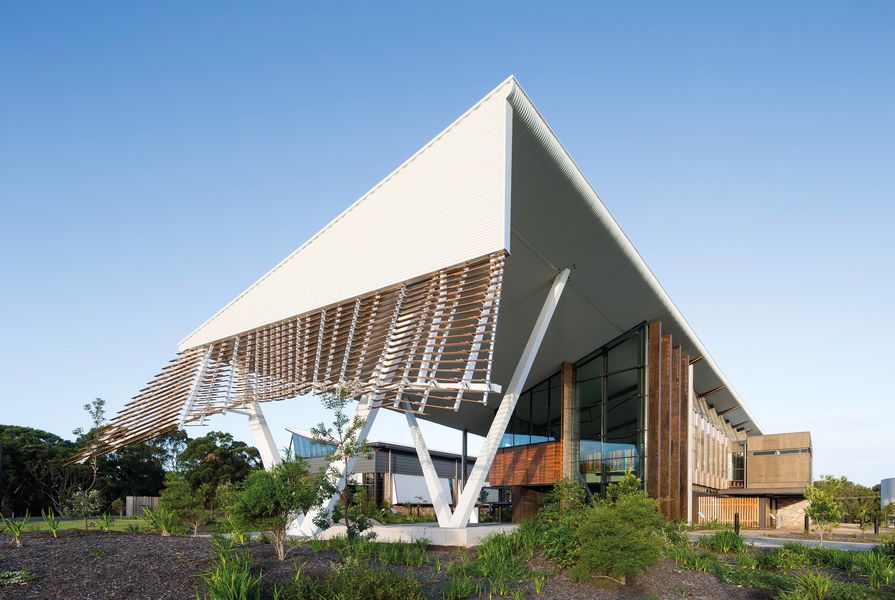We all know it by now: buildings and their construction account for almost 40 percent of global carbon emissions.1 Australia’s catastrophic 2019/2020 bushfire season has dramatically increased our sense of urgency around the climate challenge.
The role of the Green Building Council of Australia (GBCA) is to accelerate the transformation of Australia’s built environment into one that is healthy, livable, productive, resilient and sustainable. We work with industry, policymakers and the public to deliver practical solutions to minimize – and, one day, reverse – the global carbon emissions derived from buildings and their construction.
All parts of the building supply chain play a critical role in delivering a more sustainable future that reduces our emissions, builds resilience and contributes positively to our biodiversity. The number of practices and individuals who have joined the global Architects Declare movement speaks loudly to the sense of responsibility felt, and the desire for action, across the profession.
With more opportunities and lower costs than in other sectors, the building and construction sector has the capacity and the ability to decarbonize before most others. Early intervention to capitalize on these opportunities will help ease the transition for those parts of the economy where moving to a low-carbon future will be more challenging. The GBCA has developed a number of initiatives to help professionals working across the sector to drive the immediate action necessary to keep temperature rises to less than 1.5 degrees Celsius (which climate scientists now believe to be the “safe” limit2) and to mitigate climate breakdown.
In 2018, the GBCA’s Carbon Positive Roadmap for the Built Environment established a baseline for action that guides our work today in increasing standards through the Green Star rating system and advocating for a low-carbon future. Among other collaborators, we partner with the government-backed program Climate Active to certify buildings against the Climate Active Carbon Neutral Standard for Organisations.
We believe that new buildings and fit-outs, in particular, should be at the forefront of sustainable design and construction. The best-performing buildings and fit-outs are already demonstrating what can be achieved. For example, the University of Wollongong’s Sustainable Buildings Research Centre, designed by Cox in 2013 to prototype a range of sustainable technologies, techniques and materials, is powered by onsite renewable energy. The [Six Star Green Star] building includes 468 solar panels to support net-zero energy and an onsite rainwater system to enable net-zero water performance. Offsite renewable procurement is also becoming commonplace for Green Star-rated projects, such as the 100 percent Green Power-operated Floth Sustainable Building Consultants’ offices in Brisbane [Green Star certified in 2015].
Not only is a net-zero carbon future vital to minimize climate change, it is clear that it can provide a competitive advantage for first movers. Global evidence confirms that green buildings deliver lower operating costs and higher returns, enhanced productivity, faster patient recovery times and better learning outcomes, among other benefits. This is one of the reasons we are seeing our industry making commitments and accelerating technological innovation to deliver against them.
To achieve a net-zero future, we need to raise the standards established through Green Star. In 2018, the GBCA began to reshape the rating system to achieve this. Green Star Future Focus is the next iteration of the system. The Green Star for New Buildings rating tool aims to ensure that the built environment delivers what it needs to, while also responding to global megatrends and emerging challenges. It sets the trajectory for the built environment to manage its emissions through a new “Positive” category that addresses both the energy use of the building and where that energy comes from. It also tackles other emissions, such as the upfront carbon emissions from material and product selection. The New Buildings requirements remain open for consultation until July 2020. Your work with us in ensuring the success of these changes is critical to the delivery of our shared vision.3
Of course, this is not an issue that Australia can tackle in isolation. The GBCA supports the World Green Building Council’s commitment to Advancing Net Zero. The Net Zero Carbon Buildings Commitment challenges businesses and organizations across the world to take advanced climate action by setting ambitious targets to eliminate operational carbon emissions from their building portfolios by 2030. Alongside this, the World Green Building Council has released the report Bringing embodied carbon upfront,4 which calls for urgent and coordinated action to tackle global embodied carbon emissions in the building and construction sector. The report outlines the need to reduce all embodied carbon emissions, with a particular focus on reducing upfront emissions – that is, those from manufacturing and construction. The report sets a worldwide challenge for buildings and infrastructure to cut embodied carbon emissions by 40 percent by 2030 and to achieve 100 percent net-zero emissions by 2050.
Australian leadership has dominated the response to the challenge posed by the report, with 20 GBCA members out of 81 organizations globally being among the first to endorse it. Supporting these international commitments across Australia is critical to delivering the change we need for a sustainable future. We at the GBCA thank Australia’s architects for their valuable contribution to making our nation’s built environment more sustainable, healthy and positive. However, we can’t stop now. We face a monumental challenge and, in using the tools already available and in developing more, we need to work together to overcome it.
Read more articles and interviews from the climate and biodiversity emergency series.
1. UN Environment and International Energy Agency, Towards a zero-emission, efficient, and resilient buildings and construction sector. Global Status Report 2017 (New York: United Nations Environment Programme, 2017).
2. Intergovernmental Panel on Climate Change, Special Report: Global Warming of 1.5°C, 8 October 2018, ipcc.ch/sr15/ (accessed 12 March 2020).
3. See new.gbca.org.au/green-star/future-focus/New-Buildings.
4. World Green Building Council, Bringing embodied carbon upfront: Coordinated action for the building and construction sector to tackle embodied carbon (London: World Green Building Council, 2019).
















